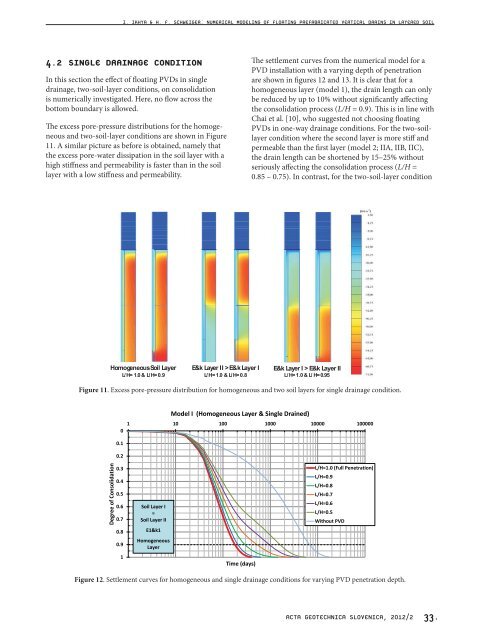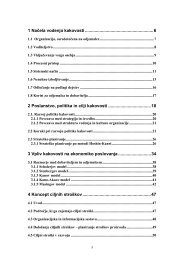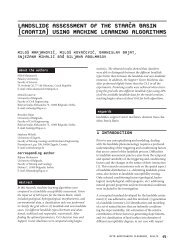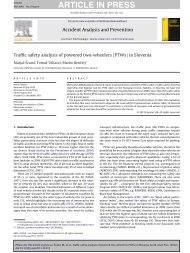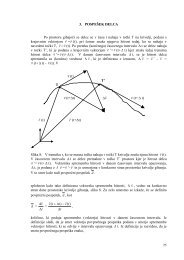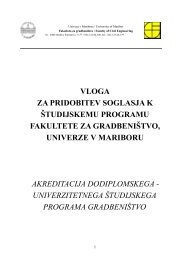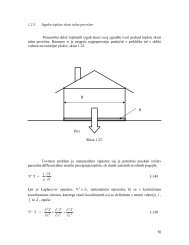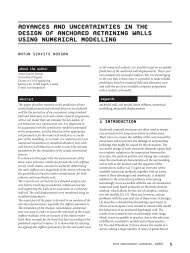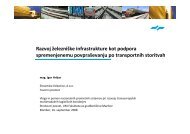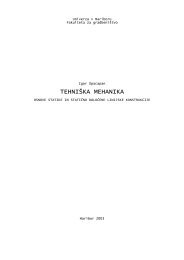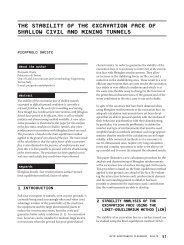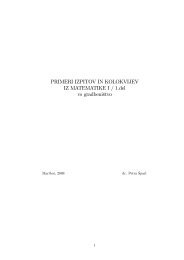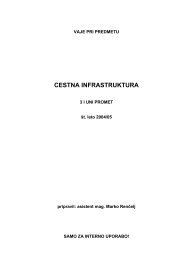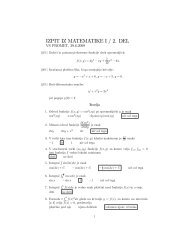Numerical modelin of floating prefabricated vertical drains in layered ...
Numerical modelin of floating prefabricated vertical drains in layered ...
Numerical modelin of floating prefabricated vertical drains in layered ...
Create successful ePaper yourself
Turn your PDF publications into a flip-book with our unique Google optimized e-Paper software.
4.2 SINGLE DRAINAGE CONDITION<br />
In this section the effect <strong>of</strong> <strong>float<strong>in</strong>g</strong> PVDs <strong>in</strong> s<strong>in</strong>gle<br />
dra<strong>in</strong>age, two-soil-layer conditions, on consolidation<br />
is numerically <strong>in</strong>vestigated. Here, no flow across the<br />
bottom boundary is allowed.<br />
The excess pore-pressure distributions for the homogeneous<br />
and two-soil-layer conditions are shown <strong>in</strong> Figure<br />
11. A similar picture as before is obta<strong>in</strong>ed, namely that<br />
the excess pore-water dissipation <strong>in</strong> the soil layer with a<br />
high stiffness and permeability is faster than <strong>in</strong> the soil<br />
layer with a low stiffness and permeability.<br />
The settlement curves from the numerical model for a<br />
PVD <strong>in</strong>stallation with a vary<strong>in</strong>g depth <strong>of</strong> penetration<br />
are shown <strong>in</strong> figures 12 and 13. It is clear that for a<br />
homogeneous layer (model 1), the dra<strong>in</strong> length can only<br />
be reduced by up to 10% without significantly affect<strong>in</strong>g<br />
the consolidation process (L/H = 0.9). This is <strong>in</strong> l<strong>in</strong>e with<br />
Chai et al. [10], who suggested not choos<strong>in</strong>g <strong>float<strong>in</strong>g</strong><br />
PVDs <strong>in</strong> one-way dra<strong>in</strong>age conditions. For the two-soillayer<br />
condition where the second layer is more stiff and<br />
permeable than the first layer (model 2; IIA, IIB, IIC),<br />
the dra<strong>in</strong> length can be shortened by 15–25% without<br />
seriously affect<strong>in</strong>g the consolidation process (L/H =<br />
0.85 – 0.75). In contrast, for the two-soil-layer condition<br />
Figure 11. Excess pore-pressure distribution for homogeneous and two soil layers for s<strong>in</strong>gle dra<strong>in</strong>age condition.<br />
Degree <strong>of</strong> Consolidation<br />
0<br />
0.1<br />
0.2<br />
0.3<br />
0.4<br />
0.5<br />
0.6<br />
0.7<br />
0.8<br />
0.9<br />
1<br />
I. IKHYA & H. F. SCHWEIGER: NUMERICAL MODELING OF FLOATING PREFABRICATED VERTICAL DRAINS IN LAYERED SOIL<br />
1 10 100 1000 10000 100000<br />
Soil Layer I<br />
=<br />
Soil Layer II<br />
E1&k1<br />
Homogeneous<br />
Layer<br />
Model I (Homogeneous Layer & S<strong>in</strong>gle Dra<strong>in</strong>ed)<br />
Time (days)<br />
L/H=1.0 (Full Penetration)<br />
L/H=0.9<br />
L/H=0.8<br />
L/H=0.7<br />
L/H=0.6<br />
L/H=0.5<br />
Without PVD<br />
Figure 12. Settlement curves for homogeneous and s<strong>in</strong>gle dra<strong>in</strong>age conditions for vary<strong>in</strong>g PVD penetration depth.<br />
ACTA GEOTECHNICA SLOVENICA, 2012/2 33.


